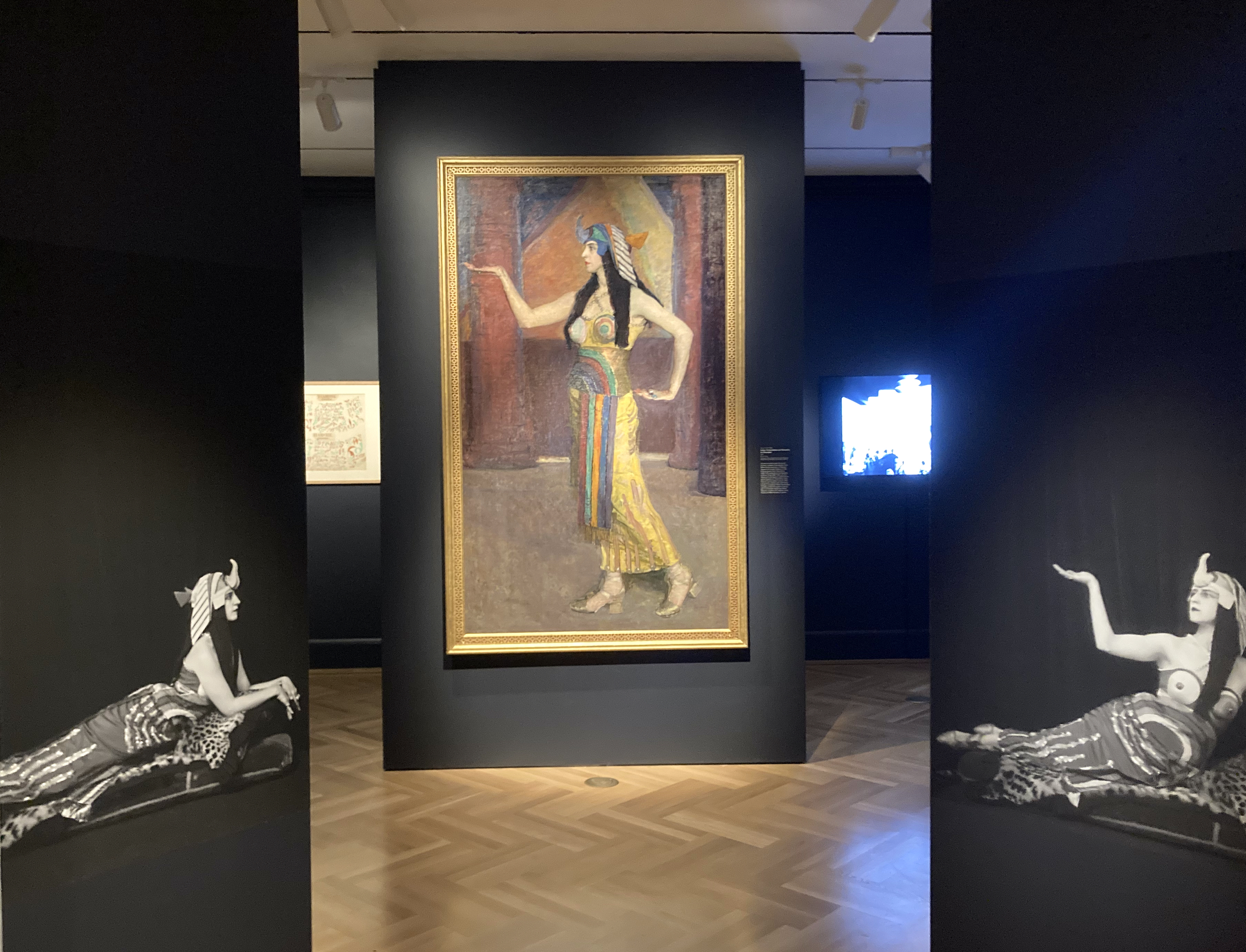Sonia Delaunay: Living Art at Bard Graduate Center is a gently curated exhibition that treats its subject with reverence. It opens with a timeline and examples of Delaunay’s personal branding: exhibition flyers, business cards, logos. It’s a neat way to lay out the show’s narrative, by presenting an artist defining herself. Though the organization is primarily chronological, this introduction shifts away from simple progress and toward deliberate creation.
We are also introduced to Simultaneism, the aesthetic principle that shaped Delaunay’s work. The artist was fascinated with color theory and the way that contrasting or complementary shades transform in relation to each other. Her desire to put that knowledge to use in art grounds the signature painting style — all dense color and abstract, circling forms — that she and her husband, Robert, shared.
The exhibition explores the full range of Delaunay’s work, establishing the styles and motifs she used consistently and her collaborations and inspirations. Her early Simultaneist experiments crossed media: for example, a beautiful Cezanne-esque embroidery from 1909 shows her remarkable eye for color and pattern.

Nearby is a copy of her design and illustration for Blaise Cendrars’s book-length poem La prose du Transsibérien et de la Petite Jehanne de France. The work, displayed unglued and fully unfolded from its accordion binding, is a giant continuous text through which Delaunay’s pochoir print illustrations roll. Pochoir, a technique in which layers of gouache are applied with stencils, allowed Delaunay to create images that could be reproduced at relatively large scale while still having a handmade quality. The Bard Center’s fourth floor is set up as a workshop, where artist-in-residence Kitty Maryatt demonstrates the process by recreating panels from Transsibérien. However having more information on pochoir in the actual exhibition would have been helpful, especially on days when Maryatt isn’t present.
To the right of the Simultaneist section is a small room focused on her theater designs. It opens with a painting by Flora Lion of Lubov Tchernicheva as Cleopatra, wearing a costume Delaunay designed; the painting is flanked by two large black and white photographs of Tchernicheva. It’s useful to see the realization of Delaunay’s design to get a sense of how the shapes and gestures of her drawing were translated into actual clothing — and Lion’s painting is an effective representation of the more traditionally figurative art world from which Delaunay’s work stood apart. Juxtaposing Delaunay’s ballet costumes with the weird and experimental pieces she made for Tristan Tzara and other Dada artists reveals how coherent yet flexible her design style was, how she was able to adapt her distinctive use of color and shape to add texture to any given circumstance. These costume sketches bridge what could be oversimplified as her design and artistic practices, though she clearly did not see them as separate.

These costume sketches also lay the groundwork for the show’s most impressive section, focusing on her company, Maison Sonia, and the textile designs she produced in the 1930s. This room is densely packed with sketches, color cards, fabric samples, wood-printing blocks, and garments, as well as Delaunay’s self-drafted promotional materials. A film clip showing models wearing her garments is remarkable both as an early color film reel and as a rare chance to see these clothes in motion. The comprehensiveness of her vision comes across most clearly here: everything is meticulously considered. The Bard Center’s floor plan allows the narrative to be broken up in a way that highlights the diversity of Delaunay’s output without creating the illusion that this represents the entirety of her career. Instead, it feels like we get to glimpse pockets of her work, and feel her expansive and collaborative production.
Upstairs, the wartime period is represented mostly by an underwhelming digital display. One room focuses on the revival of her career in the 1980s, a period marked by the licensing of her work, and expended production. While Delaunay’s style always feels fresh, a few objects look a little dated and this section, indirectly connected to her designs, lacks the energy of the earlier galleries. The one section that doesn’t live up to the rest is that of her interior and furniture designs, not because these are weaker, but due to the difficulty of presenting them in this space. We’re given a small reconstruction of one corner of a room, some sketches, and a piece of furniture she may have designed. Short of rebuilding an entire room, it’s hard to evoke the complete, coherent spaces that she envisioned, and this gallery felt like something of an afterthought compared to the rest of the exhibition’s depth.
In contrast, the sections devoted to her textile and clothing designs are beautifully assembled, and do a wonderful job of demonstrating her process. But in working so hard to highlight the creativity of her designs, the exhibition neglects her other work, and risks once again treating her art and design as separate. Delaunay’s paintings are underrepresented in the show. I know her work well enough to recognize this absence, but I wonder what visitors who are less familiar with her career would take away from this. Robert Delaunay’s “Portuguese Still Life” (1916) is on display as an example of Simultaneist painting, rather than Sonia’s very similar “Portuguese Market,” painted a year earlier (it’s currently on view at the Museum of Modern Art, if you’d like to compare them). Still, this is a small treasure of a show, one that showcases Delaunay at her meticulous, creative best.








Sonia Delaunay: Living Art continues at Bard Graduate Center (18 West 86th Street, Upper West Side, Manhattan) through July 7. The exhibition was curated by Laura Microulis, research curator at Bard Graduate Center, and art historian Waleria Dorogova.

